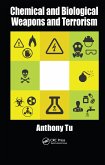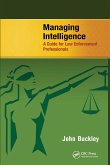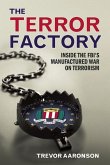- Broschiertes Buch
- Merkliste
- Auf die Merkliste
- Bewerten Bewerten
- Teilen
- Produkt teilen
- Produkterinnerung
- Produkterinnerung
Specifically written for field use, this book provides a concise, ready source of information for the processing of the most commonly encountered crime scenes involving both persons and property. The book begins with the initial response and continues on to cover evidence documentation, processing, preservation, and collection. All aspects of scene procedure are covered to make sure investigators don't miss valuable clues that could make or break a case. The book includes a CD with downloadable forms needed for crime scene investigations.
Andere Kunden interessierten sich auch für
![Chemical and Biological Weapons and Terrorism Chemical and Biological Weapons and Terrorism]() Anthony TuChemical and Biological Weapons and Terrorism73,99 €
Anthony TuChemical and Biological Weapons and Terrorism73,99 €![Terrorist Financing, Money Laundering, and Tax Evasion Terrorist Financing, Money Laundering, and Tax Evasion]() Jayesh D'SouzaTerrorist Financing, Money Laundering, and Tax Evasion115,99 €
Jayesh D'SouzaTerrorist Financing, Money Laundering, and Tax Evasion115,99 €![Online Terrorist Propaganda, Recruitment, and Radicalization Online Terrorist Propaganda, Recruitment, and Radicalization]() Online Terrorist Propaganda, Recruitment, and Radicalization90,99 €
Online Terrorist Propaganda, Recruitment, and Radicalization90,99 €![Homeland Security and Private Sector Business Homeland Security and Private Sector Business]() Elsa LeeHomeland Security and Private Sector Business69,99 €
Elsa LeeHomeland Security and Private Sector Business69,99 €![Managing Intelligence Managing Intelligence]() John BuckleyManaging Intelligence110,99 €
John BuckleyManaging Intelligence110,99 €![Terrorism and Wmds Terrorism and Wmds]() John PichtelTerrorism and Wmds75,99 €
John PichtelTerrorism and Wmds75,99 €![The Terror Factory The Terror Factory]() Trevor AaronsonThe Terror Factory14,99 €
Trevor AaronsonThe Terror Factory14,99 €-
-
-
Specifically written for field use, this book provides a concise, ready source of information for the processing of the most commonly encountered crime scenes involving both persons and property. The book begins with the initial response and continues on to cover evidence documentation, processing, preservation, and collection. All aspects of scene procedure are covered to make sure investigators don't miss valuable clues that could make or break a case. The book includes a CD with downloadable forms needed for crime scene investigations.
Produktdetails
- Produktdetails
- Verlag: Taylor & Francis
- Seitenzahl: 348
- Erscheinungstermin: 21. Mai 2014
- Englisch
- Abmessung: 229mm x 173mm x 25mm
- Gewicht: 590g
- ISBN-13: 9781466557543
- ISBN-10: 1466557540
- Artikelnr.: 39615168
- Herstellerkennzeichnung
- Libri GmbH
- Europaallee 1
- 36244 Bad Hersfeld
- gpsr@libri.de
- Verlag: Taylor & Francis
- Seitenzahl: 348
- Erscheinungstermin: 21. Mai 2014
- Englisch
- Abmessung: 229mm x 173mm x 25mm
- Gewicht: 590g
- ISBN-13: 9781466557543
- ISBN-10: 1466557540
- Artikelnr.: 39615168
- Herstellerkennzeichnung
- Libri GmbH
- Europaallee 1
- 36244 Bad Hersfeld
- gpsr@libri.de
Michael Maloney is a private consultant and trainer after retiring from a career in Federal Law Enforcement. He holds a Master of Forensic Science Degree from GWU with a Fellowship in Forensic Medicine. He has 20 years experience as a Special Agent with the Naval Criminal Investigative Service (NCIS) and Senior Instructor-Federal Law Enforcement Training Center for Death Investigations and Sex Crimes. He is the author of Death Scene Investigation: Procedural Guide and Crime Scene Investigation: Procedural Guide from CRC Press. Don Housman is a private consultant, educator, and trainer. He retired from a career with the Naval Criminal Investigative Service (NCIS) where he was Chief of the Forensic Consultant Division. He holds a Master of Forensic Sciences degree from GWU with a Fellowship in Forensic Medicine. He has 23 years' experience as a Special Agent with NCIS, and the FBI. He has co-authored four Forensic related books for the Department of Defense and is the co-author of Crime Scene Investigation: Procedural Guide from CRC Press. Ross M. Gardner worked for the United States Army Criminal Investigation Command (USACIDC) as a felony criminal investigator for nearly twenty years. He subsequently served four years as the Chief of Police for the City of Lake City, Georgia, a small suburban Atlanta police department. He is now retired and active in independent consulting. Mr. Gardner holds a Master degree in Computer and Information Systems Management from Webster University, a Bachelors degree in Criminal Justice from Wayland Baptist University and Associates degree in Police Science from Central Texas College. He graduated first in his class at the Scenes of Crime Officers Course, New Scotland Yard, Hendon England. He is a former President of the Association for Crime Scene Reconstruction (ACSR) and has served as the Chairmen of the Education Committee for the International Association of Bloodstain Pattern Analysts (IABPA). He was a charter member of the FBI's Scientific Workgroup on Bloodstain Pattern Analysis (SWGSTAIN) and chaired the Taxonomy and Terminology sub-committee for over ten years. Mr. Gardner was certified by the International Association for Identification as Senior Crime Scene Analyst from 1990-2012. He remains an active instructor and consultant throughout the United States and the world in crime scene analysis, bloodstain pattern analysis and crime scene investigation; teaching to a variety of groups ranging from investigative organizations to trial counsel professional development groups. He is co-author of Bloodstain Pattern Analysis, With an Introduction to Crime Scene Reconstruction, 3rd Edition and Practical Crime Scene Analysis and Reconstruction. Mr. Gardner also authored the text Practical Crime Scene Processing and Investigation 2nd Edition in 2004.
Crime Scene Investigation. Initial Response. Crime Scene Management. Crime
Scene Notes and Observation. Crime Scene Videography and Photography. Crime
Scene Sketching. Crime Scene Search Procedures. Aquatic Recovery of
Evidence. Releasing the Scene and Postscene Activities. Crimes against
Property. Burglary and Housebreaking. Larceny. Larceny of a Motor Vehicle.
Vandalism and Malicious Mischief. Fire and Arson Scenes. Postblast
(Explosive Incident) Scenes. Crimes against Persons. Aggravated Assault.
Robbery from an Individual. Robbery from a Business. Carjacking. Kidnapping
and Missing Persons. Rape and Sexual Assault. Injuries Commonly Associated
with Violent Crime. Child Sexual Assault or Abuse. Child Physical Abuse.
Child Neglect. Evidence Processing and Documentation. Friction Ridge
Evidence. Impression Evidence. Biological Evidence at the Scene. Trace
Evidence at the Scene. Entomological Evidence at the Scene. Use of Light
and Alternate Light Sources (Oblique, UV, ALS, and RUVIS). Documenting and
Processing Bloodstain Patterns at the Scene. Documenting and Processing the
Shooting Scene. Appendices. Index.
Scene Notes and Observation. Crime Scene Videography and Photography. Crime
Scene Sketching. Crime Scene Search Procedures. Aquatic Recovery of
Evidence. Releasing the Scene and Postscene Activities. Crimes against
Property. Burglary and Housebreaking. Larceny. Larceny of a Motor Vehicle.
Vandalism and Malicious Mischief. Fire and Arson Scenes. Postblast
(Explosive Incident) Scenes. Crimes against Persons. Aggravated Assault.
Robbery from an Individual. Robbery from a Business. Carjacking. Kidnapping
and Missing Persons. Rape and Sexual Assault. Injuries Commonly Associated
with Violent Crime. Child Sexual Assault or Abuse. Child Physical Abuse.
Child Neglect. Evidence Processing and Documentation. Friction Ridge
Evidence. Impression Evidence. Biological Evidence at the Scene. Trace
Evidence at the Scene. Entomological Evidence at the Scene. Use of Light
and Alternate Light Sources (Oblique, UV, ALS, and RUVIS). Documenting and
Processing Bloodstain Patterns at the Scene. Documenting and Processing the
Shooting Scene. Appendices. Index.
Crime Scene Investigation. Initial Response. Crime Scene Management. Crime
Scene Notes and Observation. Crime Scene Videography and Photography. Crime
Scene Sketching. Crime Scene Search Procedures. Aquatic Recovery of
Evidence. Releasing the Scene and Postscene Activities. Crimes against
Property. Burglary and Housebreaking. Larceny. Larceny of a Motor Vehicle.
Vandalism and Malicious Mischief. Fire and Arson Scenes. Postblast
(Explosive Incident) Scenes. Crimes against Persons. Aggravated Assault.
Robbery from an Individual. Robbery from a Business. Carjacking. Kidnapping
and Missing Persons. Rape and Sexual Assault. Injuries Commonly Associated
with Violent Crime. Child Sexual Assault or Abuse. Child Physical Abuse.
Child Neglect. Evidence Processing and Documentation. Friction Ridge
Evidence. Impression Evidence. Biological Evidence at the Scene. Trace
Evidence at the Scene. Entomological Evidence at the Scene. Use of Light
and Alternate Light Sources (Oblique, UV, ALS, and RUVIS). Documenting and
Processing Bloodstain Patterns at the Scene. Documenting and Processing the
Shooting Scene. Appendices. Index.
Scene Notes and Observation. Crime Scene Videography and Photography. Crime
Scene Sketching. Crime Scene Search Procedures. Aquatic Recovery of
Evidence. Releasing the Scene and Postscene Activities. Crimes against
Property. Burglary and Housebreaking. Larceny. Larceny of a Motor Vehicle.
Vandalism and Malicious Mischief. Fire and Arson Scenes. Postblast
(Explosive Incident) Scenes. Crimes against Persons. Aggravated Assault.
Robbery from an Individual. Robbery from a Business. Carjacking. Kidnapping
and Missing Persons. Rape and Sexual Assault. Injuries Commonly Associated
with Violent Crime. Child Sexual Assault or Abuse. Child Physical Abuse.
Child Neglect. Evidence Processing and Documentation. Friction Ridge
Evidence. Impression Evidence. Biological Evidence at the Scene. Trace
Evidence at the Scene. Entomological Evidence at the Scene. Use of Light
and Alternate Light Sources (Oblique, UV, ALS, and RUVIS). Documenting and
Processing Bloodstain Patterns at the Scene. Documenting and Processing the
Shooting Scene. Appendices. Index.








